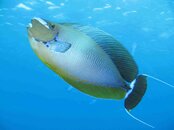jbaptis
Registered
Once again, thank you all for your input.
I am considering an DSLR since I no longer use Auto functions in my camera (nor in my Inon Z-240 strobe) practically all of my shots and lighting are in Manual, and like I said previouslly, I'm getting ambitious (eheheh). I'll try to post an example here and I welcome all critiques.
The one thing that I believe I'll miss the most if I crossover from my compact into a SLR will be the wide range of UW shooting possibilities without the need to come up to change lenses.
I find the "learn more topside before you take the SLR with you on a dive" advice to be a sound one, and that will definitely be my course of action (specially because the money will just be enough for the camera and a couple of lenses, the housing will have to wait )
)
In the meanwhile, please keep advising which setup (with lenses) you would choose and why.
I am considering an DSLR since I no longer use Auto functions in my camera (nor in my Inon Z-240 strobe) practically all of my shots and lighting are in Manual, and like I said previouslly, I'm getting ambitious (eheheh). I'll try to post an example here and I welcome all critiques.
The one thing that I believe I'll miss the most if I crossover from my compact into a SLR will be the wide range of UW shooting possibilities without the need to come up to change lenses.
I find the "learn more topside before you take the SLR with you on a dive" advice to be a sound one, and that will definitely be my course of action (specially because the money will just be enough for the camera and a couple of lenses, the housing will have to wait
In the meanwhile, please keep advising which setup (with lenses) you would choose and why.




